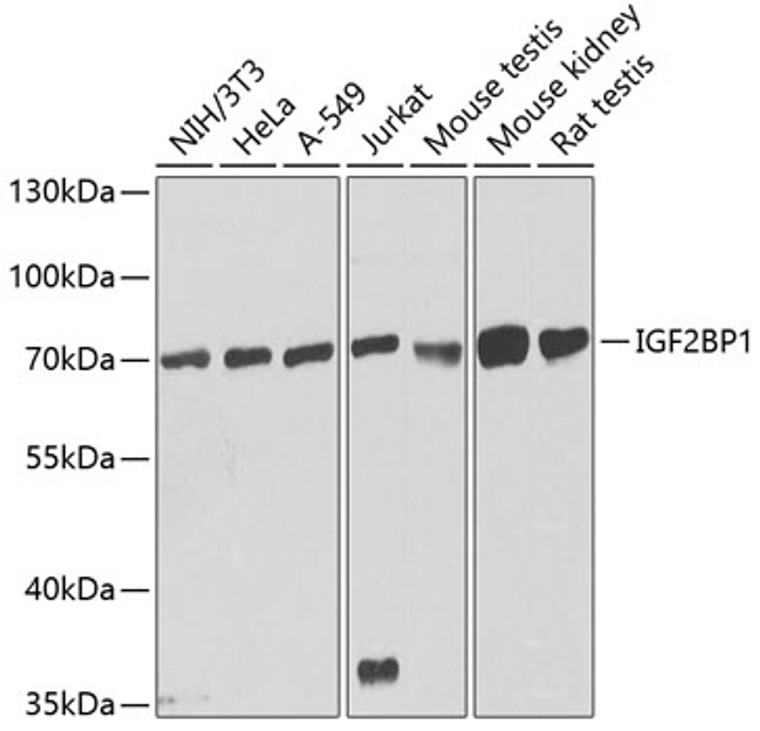| Tissue Specificity | Mainly expressed in the embryo, including in fetal liver, fetal lung, fetal kidney, fetal thymus (at protein level). Also expressed follicles of ovary, as well as in gonocytes of testis, spermatogonia, semen, oocytes and placenta (at protein level). Expressed in various cancers, including testis and lung cancers (at protein level), as well as kidney, prostate and trachea cancers. |
| Post Translational Modifications | Phosphorylated. Phosphorylation may impair association with ACTB mRNA and hence abolishes translational repression. |
| Function | RNA-binding factor that recruits target transcripts to cytoplasmic protein-RNA complexes (mRNPs). This transcript 'caging' into mRNPs allows mRNA transport and transient storage. It also modulates the rate and location at which target transcripts encounter the translational apparatus and shields them from endonuclease attacks or microRNA-mediated degradation. Preferentially binds to N6-methyladenosine (m6A)-containing mRNAs and increases their stability. Plays a direct role in the transport and translation of transcripts required for axonal regeneration in adult sensory neurons. Regulates localized beta-actin/ACTB mRNA translation, a crucial process for cell polarity, cell migration and neurite outgrowth. Co-transcriptionally associates with the ACTB mRNA in the nucleus. This binding involves a conserved 54-nucleotide element in the ACTB mRNA 3'-UTR, known as the 'zipcode'. The RNP thus formed is exported to the cytoplasm, binds to a motor protein and is transported along the cytoskeleton to the cell periphery. During transport, prevents ACTB mRNA from being translated into protein. When the RNP complex reaches its destination near the plasma membrane, IGF2BP1 is phosphorylated. This releases the mRNA, allowing ribosomal 40S and 60S subunits to assemble and initiate ACTB protein synthesis. Monomeric ACTB then assembles into the subcortical actin cytoskeleton. During neuronal development, key regulator of neurite outgrowth, growth cone guidance and neuronal cell migration, presumably through the spatiotemporal fine tuning of protein synthesis, such as that of ACTB. May regulate mRNA transport to activated synapses. Binds to and stabilizes ABCB1/MDR-1 mRNA. During interstinal wound repair, interacts with and stabilizes PTGS2 transcript. PTGS2 mRNA stabilization may be crucial for colonic mucosal wound healing. Binds to the 3'-UTR of IGF2 mRNA by a mechanism of cooperative and sequential dimerization and regulates IGF2 mRNA subcellular localization and translation. Binds to MYC mRNA, in the coding region instability determinant (CRD) of the open reading frame (ORF), hence preventing MYC cleavage by endonucleases and possibly microRNA targeting to MYC-CRD. Binding to MYC mRNA is enhanced by m6A-modification of the CRD. Binds to the 3'-UTR of CD44 mRNA and stabilizes it, hence promotes cell adhesion and invadopodia formation in cancer cells. Binds to the oncofetal H19 transcript and to the neuron-specific TAU mRNA and regulates their localizations. Binds to and stabilizes BTRC/FBW1A mRNA. Binds to the adenine-rich autoregulatory sequence (ARS) located in PABPC1 mRNA and represses its translation. PABPC1 mRNA-binding is stimulated by PABPC1 protein. Prevents BTRC/FBW1A mRNA degradation by disrupting microRNA-dependent interaction with AGO2. Promotes the directed movement of tumor-derived cells by fine-tuning intracellular signaling networks. Binds to MAPK4 3'-UTR and inhibits its translation. Interacts with PTEN transcript open reading frame (ORF) and prevents mRNA decay. This combined action on MAPK4 (down-regulation) and PTEN (up-regulation) antagonizes HSPB1 phosphorylation, consequently it prevents G-actin sequestration by phosphorylated HSPB1, allowing F-actin polymerization. Hence enhances the velocity of cell migration and stimulates directed cell migration by PTEN-modulated polarization. Interacts with Hepatitis C virus (HCV) 5'-UTR and 3'-UTR and specifically enhances translation at the HCV IRES, but not 5'-cap-dependent translation, possibly by recruiting eIF3. Interacts with HIV-1 GAG protein and blocks the formation of infectious HIV-1 particles. Reduces HIV-1 assembly by inhibiting viral RNA packaging, as well as assembly and processing of GAG protein on cellular membranes. During cellular stress, such as oxidative stress or heat shock, stabilizes target mRNAs that are recruited to stress granules, including CD44, IGF2, MAPK4, MYC, PTEN, RAPGEF2 and RPS6KA5 transcripts. |
| Protein Name | Insulin-Like Growth Factor 2 Mrna-Binding Protein 1Igf2 Mrna-Binding Protein 1Imp-1Imp1Coding Region Determinant-Binding ProteinCrd-BpIgf-Ii Mrna-Binding Protein 1Vickz Family Member 1Zipcode-Binding Protein 1Zbp-1 |
| Database Links | Reactome: R-HSA-428359Reactome: R-HSA-5687128 |
| Cellular Localisation | NucleusCytoplasmPerinuclear RegionP-BodyStress GranuleCell ProjectionLamellipodiumDendriteDendritic SpineGrowth ConeFilopodiumAxonIn The NucleusLocated In Discrete FociCoinciding With The Sites Of Actb TranscriptionIn The CytoplasmLocalizes In Cytoplasmic Mrnp GranulesColocalizes With Microtubules In Growth Cone Filopodia And Along Neurites In Neuronal CellsCytoplasmic Colocalization With Actb Mrna Is Partially Lost At The Cell PeripherySuggesting Release Of The TranscriptIn Neuronal ProcessesExhibits Fast Retrograde And Anterograde MovementsWhen Associated With Actb MrnaThis Motility Is Lost When The Association Is InhibitedIn Hippocampal NeuronsPredominantly Located Within DendritesParticularly At Dendritic Branching Points In Young CellsCompared To AxonsIn AxonsPredominantly Found In Axonal Branches And Their Growth ConesIn Motile CellsSuch As Migrating FibroblastsLocalizes To Leading Edges Where It Colocalizes With Microtubules And Microfilaments And To Retracting TailsDendritic Levels Are Regulated By Neuronal Activity And Glutaminergic Signals: They Are Increased By Kcl-Induced DepolarizationWhich Induces Rapid Efflux From The Cell Body Into DendritesAnd Decreased By The Nmda Receptor AgonistTransported Towards The Leading Edge Into The Cortical Region Of The Lamellipodia Where It Is Connected To MicrofilamentsIn Response To Cellular StressSuch As Oxidative Stress Or Heat ShockRecruited To Stress GranulesBut Not To Processing Bodies |
| Alternative Antibody Names | Anti-Insulin-Like Growth Factor 2 Mrna-Binding Protein 1 antibodyAnti-Igf2 Mrna-Binding Protein 1 antibodyAnti-Imp-1 antibodyAnti-Imp1 antibodyAnti-Coding Region Determinant-Binding Protein antibodyAnti-Crd-Bp antibodyAnti-Igf-Ii Mrna-Binding Protein 1 antibodyAnti-Vickz Family Member 1 antibodyAnti-Zipcode-Binding Protein 1 antibodyAnti-Zbp-1 antibodyAnti-IGF2BP1 antibodyAnti-CRDBP antibodyAnti-VICKZ1 antibodyAnti-ZBP1 antibody |









